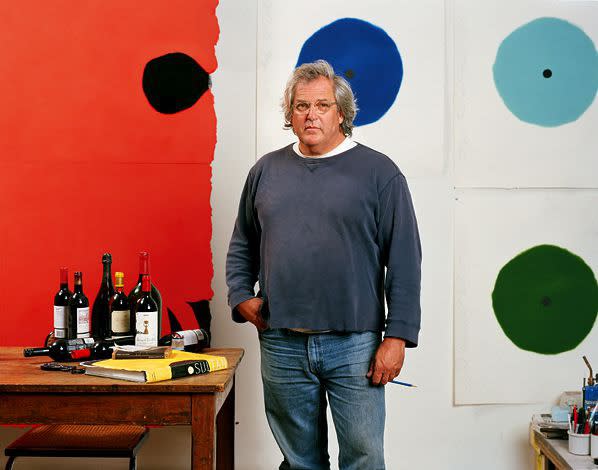Donald Sultan USA, b. 1951
Born in Asheville, North Carolina in 1951, Donald Sultan is one of
the leading American contemporary artists, renowned for his bold,
minimalist compositions and innovative techniques. Sultan received
his BFA from the University of North Carolina, Chapel Hill, and later
earned an MFA from the School of the Art Institute of Chicago in
1975.
After moving to New York City in 1977, Sultan emerged as a
prominent figure in the New Image movement, quickly gaining
recognition for his large-scale, industrially inspired still lifes. He
developed a signature technique that combines traditional painting
with sculptural processes—using materials such as tar, vinyl tiles,
masonite, and plaster to create works that blur the line between
painting and drawing.
Sultan's compositions are known for their striking contrasts—
delicate forms rendered in heavy, blackened surfaces, often
depicting lemons, poppies, dominoes, or flowers. These motifs
become meditations on impermanence, memory, and the balance
between nature and man-made environments.
A recurring theme in his work is the idea of destruction and
reconstruction, which mirrors both the physical labor of his process
Born in Asheville, North Carolina in 1951, Donald Sultan is one of
the leading American contemporary artists, renowned for his bold,
minimalist compositions and innovative techniques. Sultan received
his BFA from the University of North Carolina, Chapel Hill, and later
earned an MFA from the School of the Art Institute of Chicago in
1975.
After moving to New York City in 1977, Sultan emerged as a
prominent figure in the New Image movement, quickly gaining
recognition for his large-scale, industrially inspired still lifes. He
developed a signature technique that combines traditional painting
with sculptural processes—using materials such as tar, vinyl tiles,
masonite, and plaster to create works that blur the line between
painting and drawing.
Sultan's compositions are known for their striking contrasts—
delicate forms rendered in heavy, blackened surfaces, often
depicting lemons, poppies, dominoes, or flowers. These motifs
become meditations on impermanence, memory, and the balance
between nature and man-made environments.
A recurring theme in his work is the idea of destruction and
reconstruction, which mirrors both the physical labor of his process
and the broader metaphors within his art. Through rich textures,
monochromatic depth, and a rigorous formal language, Sultan has
forged a powerful and distinctive visual identity.
and the broader metaphors within his art. Through rich textures,
monochromatic depth, and a rigorous formal language, Sultan has
forged a powerful and distinctive visual identity.
